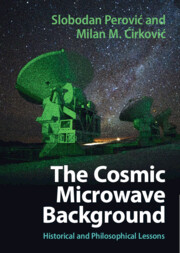Book contents
- The Cosmic Microwave Background
- The Cosmic Microwave Background
- Copyright page
- Epigraph
- Contents
- Acknowledgments
- Introduction
- Part I Physical cosmology: A brief introduction
- Part II Discovery of the CMB and current cosmological orthodoxy
- Part III What constitutes an unorthodoxy? An epistemological framework of cosmology
- Part IV Moderate unorthodoxies: The CMB with the Big Bang
- Part V Radical unorthodoxies: The CMB without the Big Bang
- Part VI Formation of the orthodoxy and the alternatives: Epistemological lessons
- Part VII Other philosophically relevant aspects of the CMB
- Book part
- Notes
- References
- Index
Introduction
Published online by Cambridge University Press: 09 July 2024
- The Cosmic Microwave Background
- The Cosmic Microwave Background
- Copyright page
- Epigraph
- Contents
- Acknowledgments
- Introduction
- Part I Physical cosmology: A brief introduction
- Part II Discovery of the CMB and current cosmological orthodoxy
- Part III What constitutes an unorthodoxy? An epistemological framework of cosmology
- Part IV Moderate unorthodoxies: The CMB with the Big Bang
- Part V Radical unorthodoxies: The CMB without the Big Bang
- Part VI Formation of the orthodoxy and the alternatives: Epistemological lessons
- Part VII Other philosophically relevant aspects of the CMB
- Book part
- Notes
- References
- Index
Summary
The introductory chapter presents the key features of the historical and philosophical analysis of the cosmic microwave background (CMB) radiation, focusing on little known alternative explanations to the Hot Big Bang model that ultimately became the standard interpretation of the CMB. The book challenges the common perception of a swift consensus on the CMB’s explanation by revealing multiple valid alternative hypotheses that are largely forgotten today. It argues this has hindered a comprehensive understanding of the history and methodology of cosmology, as well as the ability to draw important philosophical lessons for contemporary cosmological research. The chapter emphasizes the need to understand the epistemic role of the CMB in cosmology and its implications for addressing criticisms of the field. It highlights the diverse range of alternative theories proposed and suggests revisiting these theories may yield valuable ideas and conjectures for modern cosmology. It emphasizes that overlooking alternatives can impede progress. The discussion covers various aspects, from the controversial beginnings of physical cosmology to the characterization of the orthodox interpretation of the CMB, epistemological and methodological concerns, and both moderate and radical alternatives, drawing lessons for the present and future of cosmological research.
Information
- Type
- Chapter
- Information
- The Cosmic Microwave BackgroundHistorical and Philosophical Lessons, pp. 1 - 4Publisher: Cambridge University PressPrint publication year: 2024
